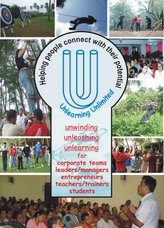In environmental education, the activity called ‘web of life’ reveals the interconnectedness of various animals, plants and elements of nature. A person poses as the sun in the centre of a ring of persons representing different elements of nature. One end of a ball of string is tied to the finger of the central person and then connected to the finger of a person who states his relationship with the sun. The string moves across various connections to create an intertwined web.
It is now physically possible to understand the interconnectedness between various players. When the facilitator presses any particular string, the strain is felt not only by the fingers of the directly connected; others too feel the pain since the pressed string passes on the tension to other connections that it criss-crosses.
Variants of the game display interconnectedness between communities, stakeholders and teams. In an interdependent world, our actions or those of others result in a related gain or pain for even seemingly unrelated players. The Buddhist concept of no self or no other, suggests that the world of interrelatedness needs mindfulness (be aware), compassion (shun selfish actions) and openness (accountability).
To be better at making the web of life sustainable for all, we must be responsible in our actions and responsive to positive and negative roles around us. After all, it is said so well that either we are part of the solution or we are part of the problem!
The web of life shows that our world is clearly interconnected…
May we BE BETTER to fulfil our responsibilities interrelated!
- Pravin K. Sabnis




No comments:
Post a Comment